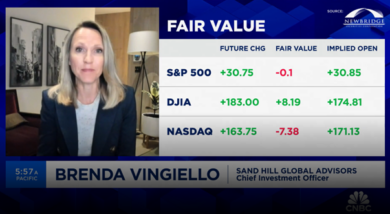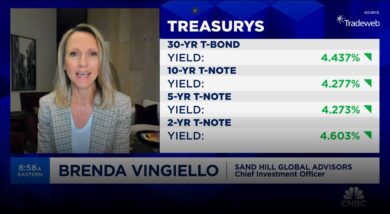Sand Hill's Chief Investment Officer, Brenda Vingiello, CFA, joins Jenny Harrington on “Halftime Report” to go over their most recent portfolio moves. Brenda's commentary begins

The Art of Gifting UP
In today’s world of innovation, where one idea could turn a young entrepreneur into an overnight million(billion)aire, it is becoming increasingly common for a financially successful individual to accumulate far more wealth than their living parents ever could. It is in this group of high net worth investors where a unique wealth transfer strategy may make sense.
Gifting and wealth transfers between generations are generally considered a one-way street: parent to child; grandparent to grandchild; older generation to younger generation. Gifting down the generation stream allows one to reduce their taxable estate while also passing an inheritance onto loved ones. This is especially important if your anticipated estate is larger than the 2017 lifetime estate tax exemption of $5.49 million per person, or $10.98 million for couples.
But let’s take a step back and imagine breaking with tradition by reversing the traffic flow upstream and instead gifting UP to mom, dad, grandma, grandpa or some other elder. If implemented in the right situation, you can potentially set yourself up to inherit those same assets (and plus some significant tax savings) down the road.
A Simple Case Study
John is a successful entrepreneur and has a large portfolio of low basis stock. John has no siblings and his mother has a gross estate well below the $5.49 million level. In this situation, John could gift shares to his mother, knowing that upon her passing, he would re-inherit the shares after they received cost basis reset to the current market value. At that point, he would be free to sell with far less tax impact than selling the original shares he owned.
There are many points to consider in this scenario:
• To avoid dipping into John’s own lifetime exemption, he would be better served to gift his mother $14,000 (or $28,000 if married) worth of stock every year. By staying at or below the annual exclusion limit, he preserves his lifetime exemption of $5.49 million ($10.98 million if married).
• John and his mother must be willing to bear the market and opportunity risk of owning the stock long term. In today’s high equity compensation driven world, John likely would have been forced to bear that market risk anyway, especially if he was held to trading restrictions by the company directly, or simply wanted to avoid paying the high taxes associated with selling low basis stock.
• In this example, John is his mother’s only heir, so little to no estate planning work would be required if her plan already includes the transfer of all her assets to John. If there were other siblings, family members, or even charitable beneficiaries involved, John would first need to ensure the gifted property is specifically bequeathed to him in her estate plan.
• John could choose to utilize this strategy to help fund his mother’s living expenses, with any unused assets transferring back to him upon her death. Likely, there would still be tax savings if she were in a lower tax bracket and thus could sell the shares with less of a tax burden.
There are many situations where “gifting up” may not be appropriate, including a complex family dynamic where gifted property may not be returned. Also, if the taxable estate of all parties involved already exceeds the lifetime exemption limits, there would be no tax savings to capture. Once property is gifted away, it is important to understand that ownership, and therefore control, also transfers. There must be a healthy, trust-filled relationship between the giftor and recipient to ensure the assets are left intact – if that is the ultimate intent.
A Look Back at History
If John chose to gift beyond the $14,000 per person per year annual exclusion, he would be subject to gift tax returns and he would erode his own $5.49 million lifetime exemption. To address this possibility, let’s take a deeper look at the history of the lifetime exemption amount:
In 1997, the lifetime exemption was only $600,000 and the top estate tax rate was a flat 55%. This remained in place for 5 years (adjusted for inflation) until it was bumped up to $1 million from 2002-2010. It received another bump in 2011 to $5 million and has been adjusted for inflation each year until now, where it stands for 2017 at $5.49 million and a top federal estate tax rate of 40% flat for 2017. These figures are “permanent” until, of course, Congress decides to change the rules.
If there are (hopefully) many years between now and John’s ultimate death, he could be waiting a long time to finally use up his lifetime exemption. By gifting these assets now, he may reduce his lifetime exemption, but still accomplish removing the assets from his estate, giving them the opportunity to obtain the step up in basis at his mother’s passing. And, if the lifetime exemption amount were to be reduced at some point in the future, he’ll be content knowing he had already taken advantage of the tax-free transfer before those changes went into effect.
Just like constructing a work of art, finding the right way to utilize this wealth transfer strategy takes careful consideration and thoughtful execution. If the suitable circumstances exist, this strategy can be immensely beneficial. That said, with the current leadership in Washington, D.C., we simply do not know how income tax rules and especially estate tax rules may or may not be changing in the next few years. Regardless, this commentary was written based on the current policies in place. In addition, since implementing any form of wealth transfer strategy can have significant tax implications, always consult with your Sand Hill Wealth Manager and tax professional prior to taking any action.
Articles and Commentary
Information provided in written articles are for informational purposes only and should not be considered investment advice. There is a risk of loss from investments in securities, including the risk of loss of principal. The information contained herein reflects Sand Hill Global Advisors' (“SHGA”) views as of the date of publication. Such views are subject to change at any time without notice due to changes in market or economic conditions and may not necessarily come to pass. SHGA does not provide tax or legal advice. To the extent that any material herein concerns tax or legal matters, such information is not intended to be solely relied upon nor used for the purpose of making tax and/or legal decisions without first seeking independent advice from a tax and/or legal professional. SHGA has obtained the information provided herein from various third party sources believed to be reliable but such information is not guaranteed. Certain links in this site connect to other websites maintained by third parties over whom SHGA has no control. SHGA makes no representations as to the accuracy or any other aspect of information contained in other Web Sites. Any forward looking statements or forecasts are based on assumptions and actual results are expected to vary from any such statements or forecasts. No reliance should be placed on any such statements or forecasts when making any investment decision. SHGA is not responsible for the consequences of any decisions or actions taken as a result of information provided in this presentation and does not warrant or guarantee the accuracy or completeness of this information. No part of this material may be (i) copied, photocopied, or duplicated in any form, by any means, or (ii) redistributed without the prior written consent of SHGA.
Video Presentations
All video presentations discuss certain investment products and/or securities and are being provided for informational purposes only, and should not be considered, and is not, investment, financial planning, tax or legal advice; nor is it a recommendation to buy or sell any securities. Investing in securities involves varying degrees of risk, and there can be no assurance that any specific investment will be profitable or suitable for a particular client’s financial situation or risk tolerance. Past performance is not a guarantee of future returns. Individual performance results will vary. The opinions expressed in the video reflect Sand Hill Global Advisor’s (“SHGA”) or Brenda Vingiello’s (as applicable) views as of the date of the video. Such views are subject to change at any point without notice. Any comments, opinions, or recommendations made by any host or other guest not affiliated with SHGA in this video do not necessarily reflect the views of SHGA, and non-SHGA persons appearing in this video do not fall under the supervisory purview of SHGA. You should not treat any opinion expressed by SHGA or Ms. Vingiello as a specific inducement to make a particular investment or follow a particular strategy, but only as an expression of general opinion. Nothing presented herein is or is intended to constitute investment advice, and no investment decision should be made based solely on any information provided on this video. There is a risk of loss from an investment in securities, including the risk of loss of principal. Neither SHGA nor Ms. Vingiello guarantees any specific outcome or profit. Any forward-looking statements or forecasts contained in the video are based on assumptions and actual results may vary from any such statements or forecasts. SHGA or one of its employees may have a position in the securities discussed and may purchase or sell such securities from time to time. Some of the information in this video has been obtained from third party sources. While SHGA believes such third-party information is reliable, SHGA does not guarantee its accuracy, timeliness or completeness. SHGA encourages you to consult with a professional financial advisor prior to making any investment decision.







